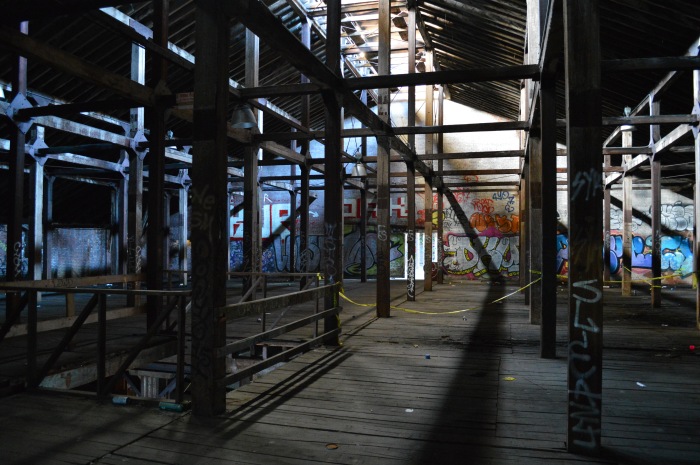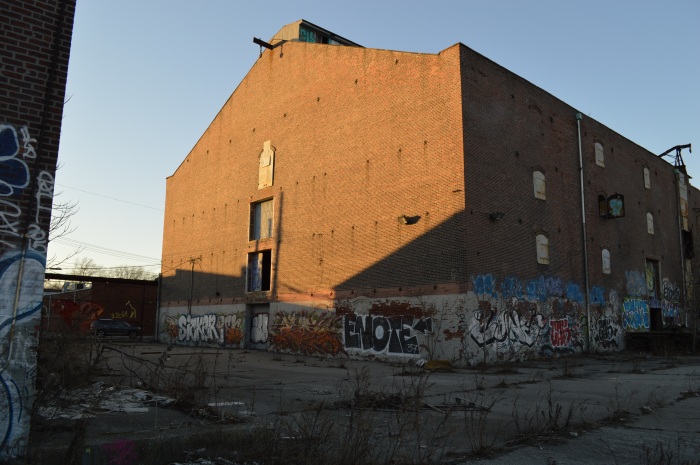
A large, open room filled with wooden support beams, top floor
The S.W. Bowne Grain Storehouse was built in 1886 on the shores of Brooklyn’s vile Gowanus Canal. It stored grain and animal feed, both which were valuable commodities in a time when horses were used for everything from pulling the carriages of the elite and wealthy to plowing the fields of the farms still prevalent in the outer boroughs. The company’s fortunes were directly tied to grain,and when cars replaced horses on the city streets, the storehouse was forced to become a general warehouse, until it was finally abandoned sometime around the 1960’s.

The very top of the factory. Those flimsy boards are the only things between an explorer and a 2 story fall.
S.W.Bowne, the storehouse’s owner, was not the standard rich person of his day. Instead of sitting in a comfortable office lavishing in his own wealth, he spent his time in the storehouse, doing manual labor alongside his workers. One day, while helping his workers carry lumber, his foot broke through the floor and was caught in a machine, which tore apart his leg. After the amputation that followed, Bowne was forced to sue for worker’s compensation, which was contested by his board of directors. He won, however, when the NY Appeals Court ruled that while Bowne was the owner of the company, he was also a working employee, and was therefor entitled to worker’s comp.

Wooden beams and floors still stand strong after almost 150 years
While Red Hook is filled with abandoned warehouses, the S.W. Bowne Grain Storehouse is uniquely significant. Most abandoned industrial buildings, even ones older than this, are filled with modern equipment and have often been renovated or added to in more (relatively) recent times. This storehouse, however, looks pretty much the same as it did in the 1880’s, inside and out. Nothing has been added to it. The original wood floors were never done away with in favor of concrete. This old building may be the best look into industrial history you can still visit today.

Before newfangled elevators were invented, pulleys like this were used to hoist heavy goods into the upper floors of factories and warehouses. This very obsolete piece of equipment still stands tall over the canal.
Wood floors are usually very unsafe for urban explorers. Wood floors that have not been maintained since the 1960’s have usually long since collapsed. However, bags of grain are very heavy, so the floors of the storehouse were built STRONG. In most places the wood floors still feel as solid as concrete. Time and the elements have created some weakness though, especially under the small collapse in the roof. On the top floor, you can still see two holes, one where an explorer fell through, and one where his friend fell through trying to help him. Watch your step, look out for water damage and stay safe.

Signs in English, Italian and Yiddish can be found in the storehouse, giving a glimpse into who worked here long ago.
*Update: This is a no smoking sign written in Yiddish- thank you to Joseph Alexiou for the translation!
Due to ease of access, the storehouse has a lot of graffiti, a lot of which is beautiful and well done.

Third floor, with pillars marked west and east. Notice how well supported the roof is.

Factory door

The first floor

The storehouse from outside

An industrial sunset
Next to the storehouse are two huge, empty warehouses. Getting in is easy, and there isn’t much inside, so the urban explorer would probably take little interest. However, they are filled with graffiti, so if that’s your thing stop by and check it out.

The warehouses near the storehouse are huge but empty

This one has an old boat out front for some reason
You are keeping memories alive and keeping the past in our lives. Enjoy your posts!
Pamm
LikeLike